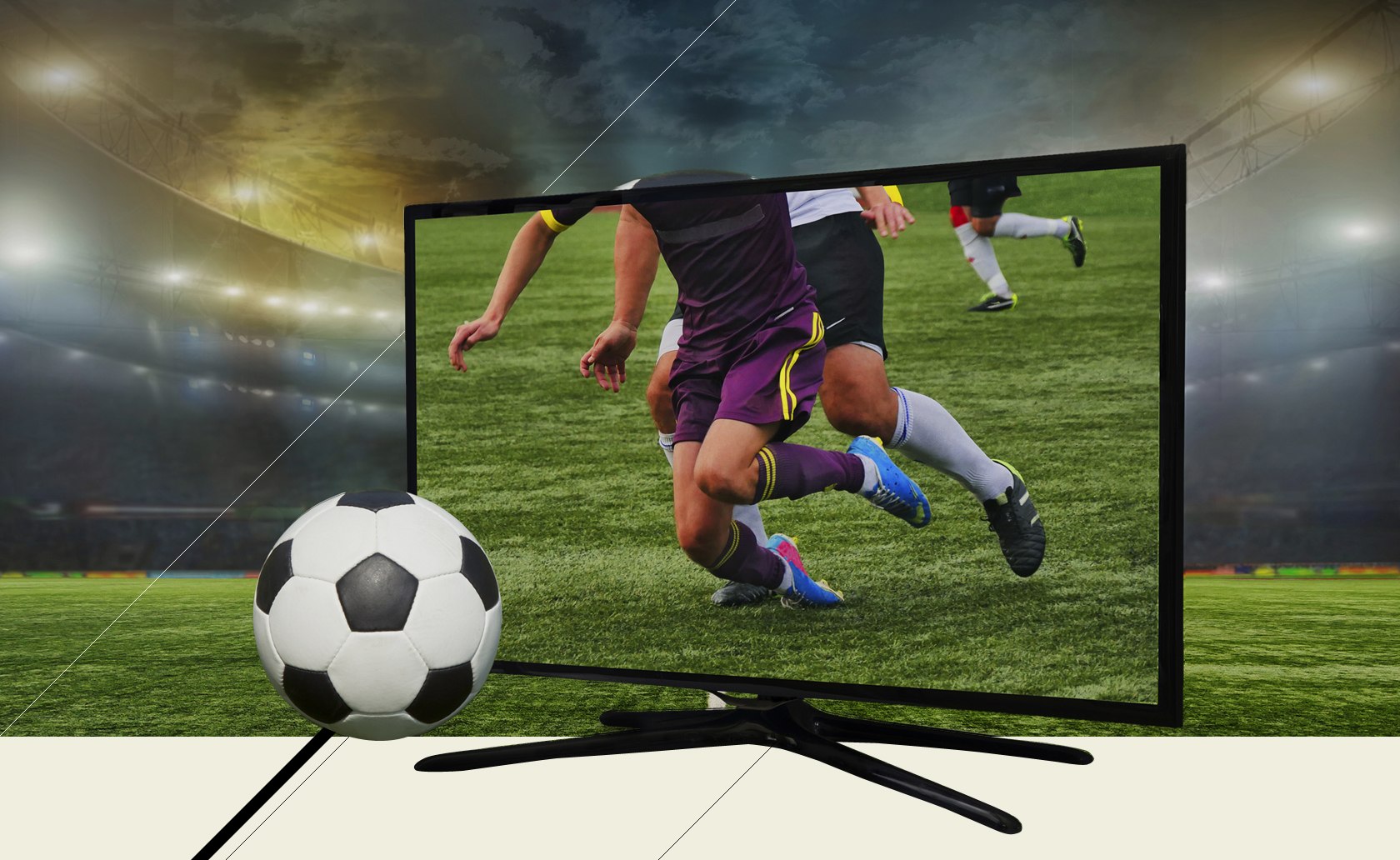



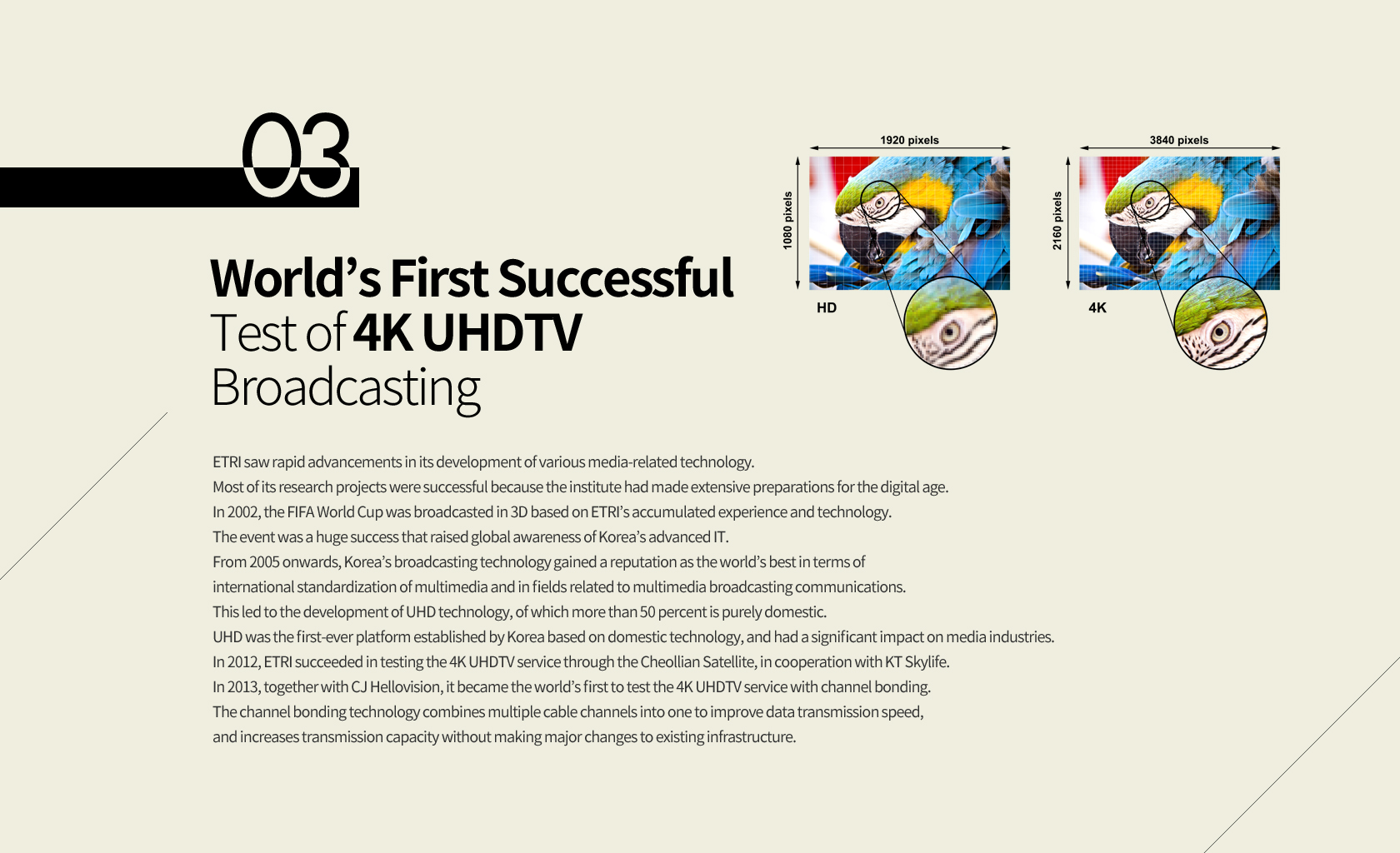
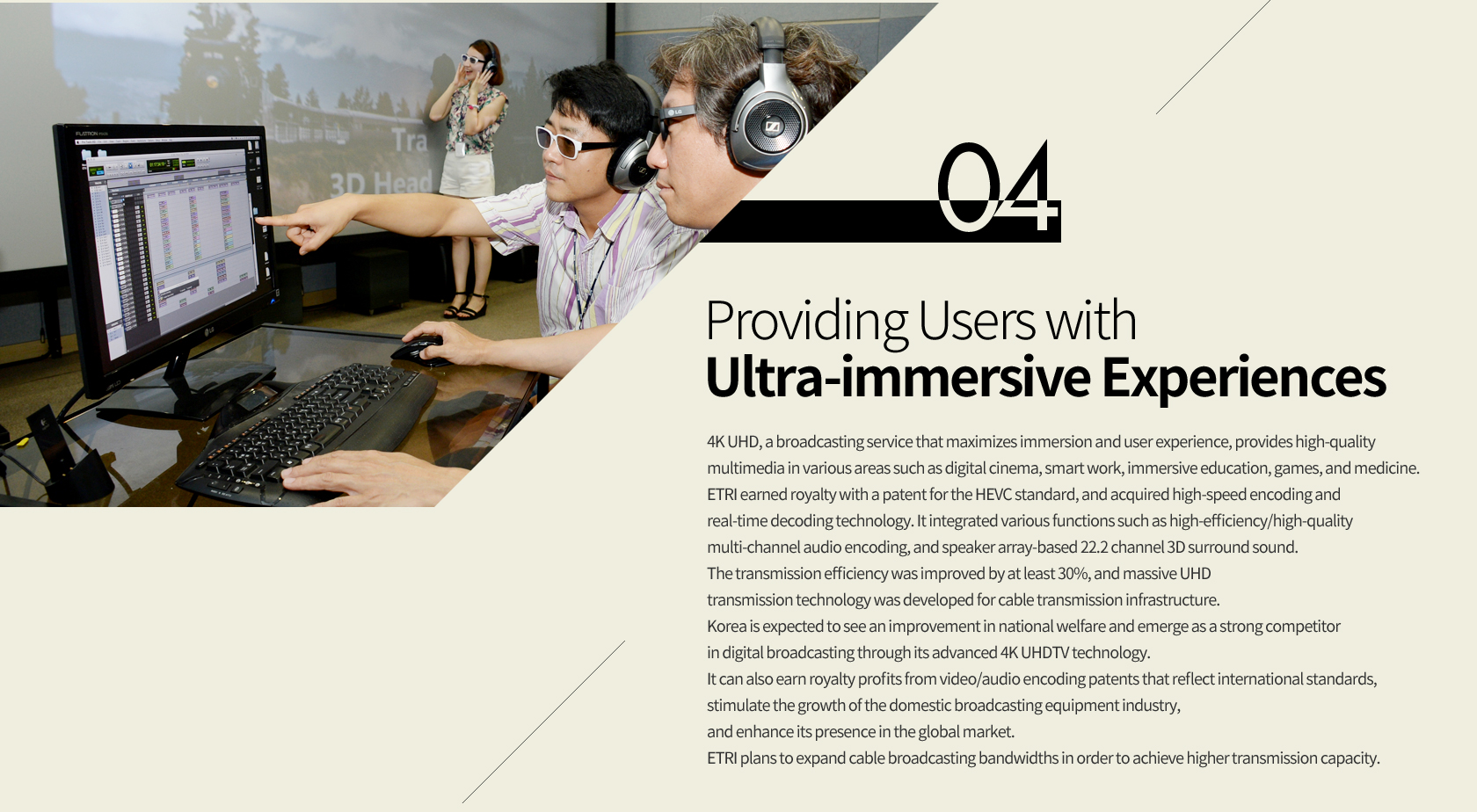
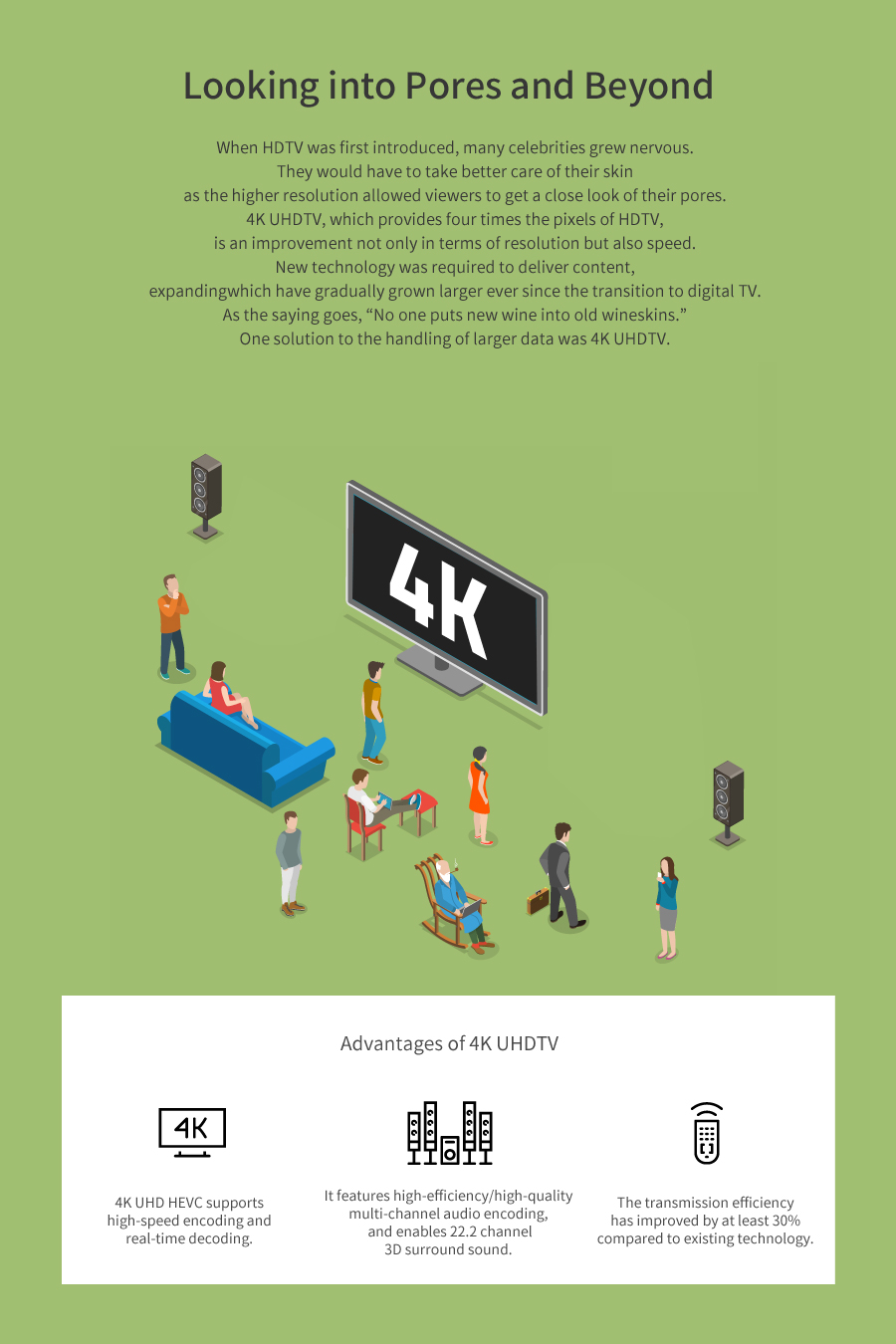

4K UHD,
Four Times the
Pixels of HD
Over the past twenty years, the domestic broadcasting and media environment has undergone significant changes. The domestic broadcasting market, which previously consisted of analog TV only, expanded to cable TV, satellite broadcasting, terrestrial DTV, terrestrial DMB, IPTV, smart TV, and mobile streaming services. The rapid transition from analog to digital ushered in an era of user-personalized TV, and broadcasting services soon became smarter and multi-functional. In line with these trends, ETRI is developing advanced broadcasting/media technology to support UHDTV, high-quality mobile broadcasting, hybrid broadcasting, 3DTV, immersive media, and augmented reality broadcasting.

01
Clearer Displays
for Modern Viewers
Media is an integral part of the lives of people living in modern society. Broadcasting media plays an important role, which is “to express and deliver” various content. If broadcasting media is to fulfill its role as an “expressive media,” the radio waves and sound waves technology responsible for content delivery play the role of “content delivery media.” In the analog age, “expressive media” and “content delivery media” were not distinguished. However, their distinctiveness has become more prominent in the digital age, and there has been a greater emphasis on “content delivery media.” Developments in content delivery technology were inevitable as consumers desired clearer displays at faster speeds. In response to such demands, the digital TV market rapidly expanded since the late 2000s, and the broadcasting market evolved into various forms including cable TV, satellite broadcasting, IPTV, and smart TV.
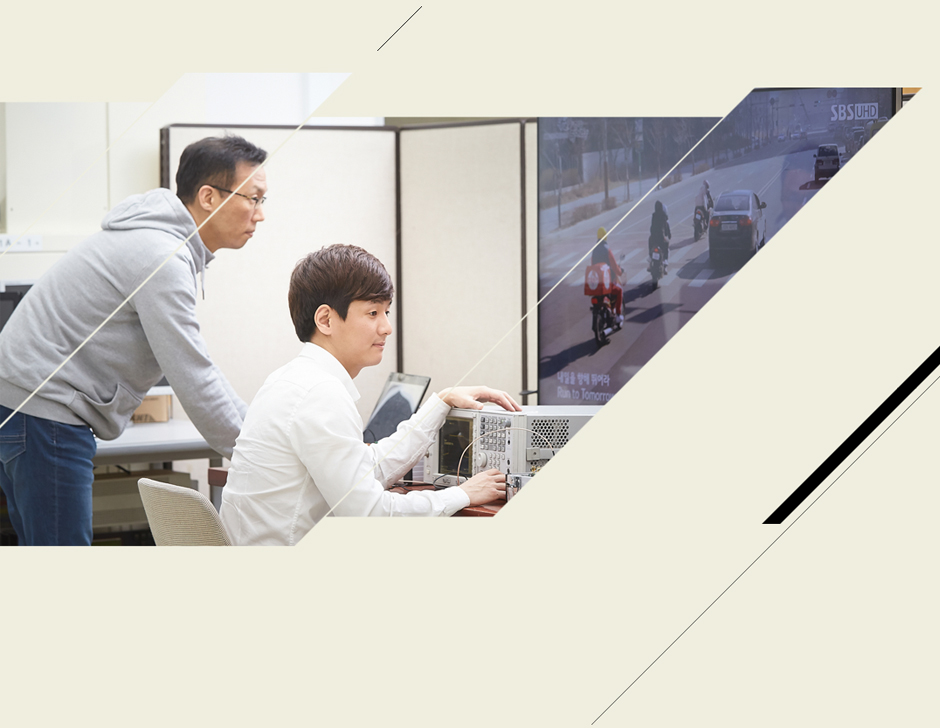
02
Adapting to the
Increasing Size
of Media Data
Broadcasting and media content have grown more massive in size in size in the digital age, and broadcasting technology had to evolve to keep up with the trends of massive data and high speed. ETRI has focused on developing smart media infrastructure, so as to seamlessly provide the public with media content.
Among its various projects, ETRI is known for its Ultra High Definition (UHD) TV technology. UHDTV, which is an upgraded version of HDTV, allows viewers to enjoy high-quality broadcasting in the comfort of their homes. UHDTV services can be accessed simply by using a small satellite receiving antenna in cities or even in rural areas. The history of UHDTV goes back to about 30 years ago, or the late 1990s. Korea had just decided to introduce digital TV, and ETRI proposed combining the European method and U.S. method. While many broadcasting companies were undecided between the two, ETRI decided to combine the advantages of each method, adopting the U.S. method for fixed services, and the European for mobile services.
03
World’s First Successful
Test of 4K UHDTV
Broadcasting
ETRI saw rapid advancements in its development of various media-related technology. Most of its research projects were successful because the institute had made extensive preparations for the digital age. In 2002, the FIFA World Cup was broadcasted in 3D based on ETRI’s accumulated experience and technology. The event was a huge success that raised global awareness of Korea’s advanced IT. From 2005 onwards, Korea’s broadcasting technology gained a reputation as the world’s best in terms of international standardization of multimedia and in fields related to multimedia broadcasting communications. This led to the development of UHD technology, of which more than 50 percent is purely domestic. UHD was the first-ever platform established by Korea based on domestic technology, and had a significant impact on media industries. In 2012, ETRI succeeded in testing the 4K UHDTV service through the Cheollian Satellite, in cooperation with KT Skylife. In 2013, together with CJ Hellovision, it became the world’s first to test the 4K UHDTV service with channel bonding. The channel bonding technology combines multiple cable channels into one to improve data transmission speed, and increases transmission capacity without making major changes to existing infrastructure.

04
Providing Users
with Ultra-immersive Experiences
4K UHD, a broadcasting service that maximizes immersion and user experience, provides high-quality multimedia in various areas such as digital cinema, smart work, immersive education, games, and medicine.
ETRI earned royalty with a patent for the HEVC standard, and acquired high-speed encoding and real-time decoding technology. It integrated various functions such as high-efficiency/high-quality multi-channel audio encoding, and speaker array-based 22.2 channel 3D surround sound. The transmission efficiency was improved by at least 30%, and massive UHD transmission technology was developed for cable transmission infrastructure.
Korea is expected to see an improvement in national welfare and emerge as a strong competitor in digital broadcasting through its advanced 4K UHDTV technology. It can also earn royalty profits from video/audio encoding patents that reflect international standards, stimulate the growth of the domestic broadcasting equipment industry, and enhance its presence in the global market. ETRI plans to expand cable broadcasting bandwidths in order to achieve higher transmission capacity.



